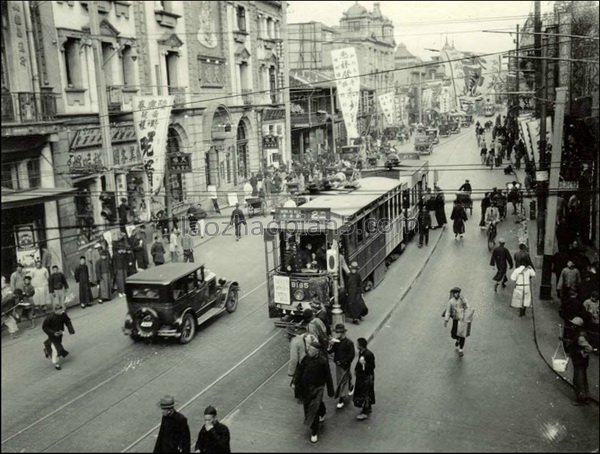Period:Ming dynasty Production date:1368-1450 (circa)
Materials:porcelain
Technique:celadon-glazed, biscuit-fired,
Subjects:animal bodhisattva
Dimensions:Height: 22 centimetres Length: 16 centimetres
Description:
Porcelain figure of the Bodhisattva Puxian riding a caparisoned elephant with biscuit-fired and green-glaze decoration. This smiling male figure is seated cross-legged on a saddled elephant with raised right hand modelled to grip a cylindrical object now missing and left hand relaxed against his thigh. He wears a skirt, fastened at the waist with a knotted cord, and an undulating scarf. His bare torso is covered with an elaborate necklace with scalloped edges, coin-like medallions and ribbons. The elephant is shown with curled trunk and swaying tail, standing, with each foot supported by a lotus flower, on a rounded rectangular base. The elephant is luxuriously ornamented with anklets and decorative tack and its back is covered with a five-sided saddle cloth, decorated with cloud scrolls and a border of incised coins, held in place by an ornate harness. The sculpture’s base is recessed and glazed, except for the foot ring, and is incised with a beribboned ingot. Longquan clay is pale grey but after reduction-firing, on cooling, unglazed areas, protected by an oil or wax layer, reoxidize to brick red, contrasting with the green-glazed sections, creating the illusion of flesh and suggesting contrasting textures.
IMG
![图片[1]-figure BM-Franks.1513-China Archive](https://chinaarchive.net/Ming dynasty/Ceramics/mid_00184718_001.jpg)
![图片[2]-figure BM-Franks.1513-China Archive](https://chinaarchive.net/Ming dynasty/Ceramics/mid_00280463_001.jpg)
![图片[3]-figure BM-Franks.1513-China Archive](https://chinaarchive.net/Ming dynasty/Ceramics/mid_RRC18615.jpg)
Comments:Harrison-Hall 2001:The figure can be identified as Puxian, the Buddhist Bodhisattva of Universal Goodness, also known by the Sanskrit name Samantabhadra, who is generally depicted riding an elephant. Sculptures of Puxian are frequently paired with images of Wenshu, the Buddhist Bodhisattva of Universal Wisdom, also known by the Sanskrit name Manjushri and usually portrayed riding a lion. An example of this type of figure, also dating to the fourteenth century and made at Longquan, is in the Victoria and Albert Museum, London. Figures of Puxian and Wenshu may be found flanking the image of Buddha. A Longquan Buddha dating to the fourteenth century is in the private collection of Mr and Mrs Jack Chia. Excavations of residential sites in the Yuan capital city of Dadu (Beijing) have unearthed several Longquan biscuit and green-glazed religious-subject statues. In 1966 archaeologists digging in the Changping county area of Beijing discovered a Longquan image of Wenshu similar to the example in the Victoria and Albert Museum.Images of these two Bodhisattvas were produced individually, as pairs, or formed elements of a trinity flanking an Amitabha Buddha for domestic shrines. The coins on the saddle and chest ornament as well as the ingot on the base suggest a merger of popular auspicious and Buddhist iconography. Such figures were used both for devotion and to bring about good fortune.
Materials:porcelain
Technique:celadon-glazed, biscuit-fired,
Subjects:animal bodhisattva
Dimensions:Height: 22 centimetres Length: 16 centimetres
Description:
Porcelain figure of the Bodhisattva Puxian riding a caparisoned elephant with biscuit-fired and green-glaze decoration. This smiling male figure is seated cross-legged on a saddled elephant with raised right hand modelled to grip a cylindrical object now missing and left hand relaxed against his thigh. He wears a skirt, fastened at the waist with a knotted cord, and an undulating scarf. His bare torso is covered with an elaborate necklace with scalloped edges, coin-like medallions and ribbons. The elephant is shown with curled trunk and swaying tail, standing, with each foot supported by a lotus flower, on a rounded rectangular base. The elephant is luxuriously ornamented with anklets and decorative tack and its back is covered with a five-sided saddle cloth, decorated with cloud scrolls and a border of incised coins, held in place by an ornate harness. The sculpture’s base is recessed and glazed, except for the foot ring, and is incised with a beribboned ingot. Longquan clay is pale grey but after reduction-firing, on cooling, unglazed areas, protected by an oil or wax layer, reoxidize to brick red, contrasting with the green-glazed sections, creating the illusion of flesh and suggesting contrasting textures.
IMG
![图片[1]-figure BM-Franks.1513-China Archive](https://chinaarchive.net/Ming dynasty/Ceramics/mid_00184718_001.jpg)
![图片[2]-figure BM-Franks.1513-China Archive](https://chinaarchive.net/Ming dynasty/Ceramics/mid_00280463_001.jpg)
![图片[3]-figure BM-Franks.1513-China Archive](https://chinaarchive.net/Ming dynasty/Ceramics/mid_RRC18615.jpg)
Comments:Harrison-Hall 2001:The figure can be identified as Puxian, the Buddhist Bodhisattva of Universal Goodness, also known by the Sanskrit name Samantabhadra, who is generally depicted riding an elephant. Sculptures of Puxian are frequently paired with images of Wenshu, the Buddhist Bodhisattva of Universal Wisdom, also known by the Sanskrit name Manjushri and usually portrayed riding a lion. An example of this type of figure, also dating to the fourteenth century and made at Longquan, is in the Victoria and Albert Museum, London. Figures of Puxian and Wenshu may be found flanking the image of Buddha. A Longquan Buddha dating to the fourteenth century is in the private collection of Mr and Mrs Jack Chia. Excavations of residential sites in the Yuan capital city of Dadu (Beijing) have unearthed several Longquan biscuit and green-glazed religious-subject statues. In 1966 archaeologists digging in the Changping county area of Beijing discovered a Longquan image of Wenshu similar to the example in the Victoria and Albert Museum.Images of these two Bodhisattvas were produced individually, as pairs, or formed elements of a trinity flanking an Amitabha Buddha for domestic shrines. The coins on the saddle and chest ornament as well as the ingot on the base suggest a merger of popular auspicious and Buddhist iconography. Such figures were used both for devotion and to bring about good fortune.
© Copyright
The copyright of the article belongs to the author, please keep the original link for reprinting.
THE END




![[Qing Dynasty] British female painter—Elizabeth Keith, using woodblock prints to record China from the late Qing Dynasty to the early Republic of China—1915-China Archive](https://chinaarchive.net/wp-content/uploads/2022/11/image-191x300.png)
